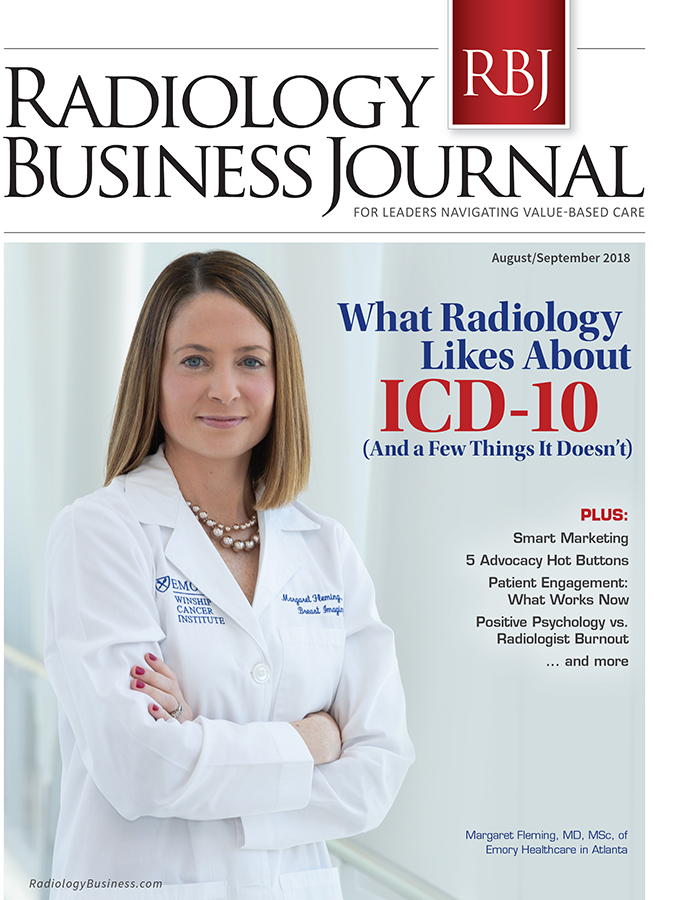The Image of ICD-10 Expertise: Research Earns Cover of Radiology Business Journal
Dec. 13, 2018
By Sam Marie Engle
It’s unusual when imaging experts themselves become images, but that’s what happened to Margaret Fleming, MD, MSc, a breast imaging specialist and assistant professor in the Department of Radiology and Imaging Sciences.

It started with research on the 2015 conversion of the International Classification of Diseases (ICD) system from the ninth revision (ICD-9) to the 10th revision (ICD-10).
Preparing for Conversion from ICD-9 to ICD-10
“The national conversion from ICD-9 to ICD-10 was likened by many to the tech Y2K,” explains Richard Duszak, Jr., MD, professor and vice chair for health policy and practice. “Correct coding is essential for billing professional and technical services alike, and so when faced with the national regulatory change in the basis by which all healthcare claims were billed, many practices and facilities were fearful of their revenue streams drying up instantaneously. That obviously would have been a financial doomsday, and so anticipating this conversion, we at Emory began working with our administrative and technical and physician staffs about two years in advance, with the goal of operationalizing the transition as seamlessly as possible.”
Emory Radiology bills over a million examinations a year, notes Dr. Duszak. With the impending changes in the way in which clinical history was to be captured and reported, something like changing from 5-digit field codes to 7-digit field codes in an old computer system was a huge undertaking.
Drs. Fleming and Duszak were joined by Courtney Moreno, MD, associate professor and director of ultrasound, and Dan MacFarlane, BS, CPA, director of decision support, in working with department colleagues to prepare for conversion. Success would depend on training radiologists to collect all the relevant information necessary for properly coding reports.
The team published their work on conversion preparation with the hope of helping other radiology practices prepare for and avoid pitfalls. “We wanted to provide a framework for change management,” Dr. Fleming says.
Assessing Impact and the Impact of Assessment
The team also wanted to assess how the conversion actually impacted Emory. The resulting study, “Code Conversion Impact Factor and Cash Flow Impact of International Classification of Diseases, 10th Revision, on a Large Multihospital Radiology Practice,” appeared in the October 2017 Journal of the American College of Radiology (DOI: 10.1016/j.jacr.2017.08.013).
The team calculated a code conversion impact factor (CCIF) by dividing actual ICD-10 codes by prior ICD-9 codes. Looking at 673,600 claims of imaging services for 179 Emory radiologists for the first year after ICD-10's implementation, they found that of all the 69,823 ICD-10 codes, only 7,075 were used to report primary diagnoses across the entire practice, and just 562 were used to report 90% of all claims, compared with 348 under ICD-9. This translated to an overall CCIF of 1.6 for the department, which was far less than the literature-predicted, doomsday CCIF of 6.
To assess ICD-10's impact on cash flow, the team also compared the average monthly days claims languished in accounts receivable status for the 12 months before and after conversion and found monthly average days in accounts receivable surprisingly did not increase. Indeed, the operational impact of the ICD-10 transition on radiology practices appeared far less than predicted with respect to both CCIF and delays in cash flow.
Career Growth and the Cover of Radiology Business Journal
The study not only generated significant interest at national conferences, it landed Dr. Fleming on the cover of the August/September 2018 issue of Radiology Business Journal (https://tinyurl.com/y7f7sukg)
“It was a nice surprise when the editor reached out and said since ICD-10 would be the cover story, they wanted me to be the face of the story,” says Dr. Fleming. “Kevin Makowski (Emory Radiology’s senior photographer) did a great job on the photo.”
Dr. Fleming’s interest in the financial aspects of radiology has deep roots. “Before I went to medical school, I worked in investment banking and finance,” she explains. “I then decided to go into medicine. I always hoped there would be a way to merge these two paths. During my diagnostic radiology residency here at Emory, I found opportunities to get involved in projects with a financial component. Dr. Duszak was a mentor who helped me set up an administrative elective in the fourth year of residency. He also connected me with the American College of Radiology’s (ACR) James T. Moorefield Fellow in Economics, which was an intensive experience.”
Dr. Fleming says Dr. Duszak remains an important collaborator as well as mentor. “I’m staying very much involved in these kinds of topics.”
At the national level, Dr. Fleming is involved with the ACR’s Committee on Breast Imaging and the Alternative Payments Workgroup and Health Policy Research Workgroup. This year, she was selected for the Association of University Radiologists’ 2018 Faculty Development Program.
With policy experts already talking about a transition to ICD-11, Dr. Duszak says, “We know what we need to do next time and know that it works.”



